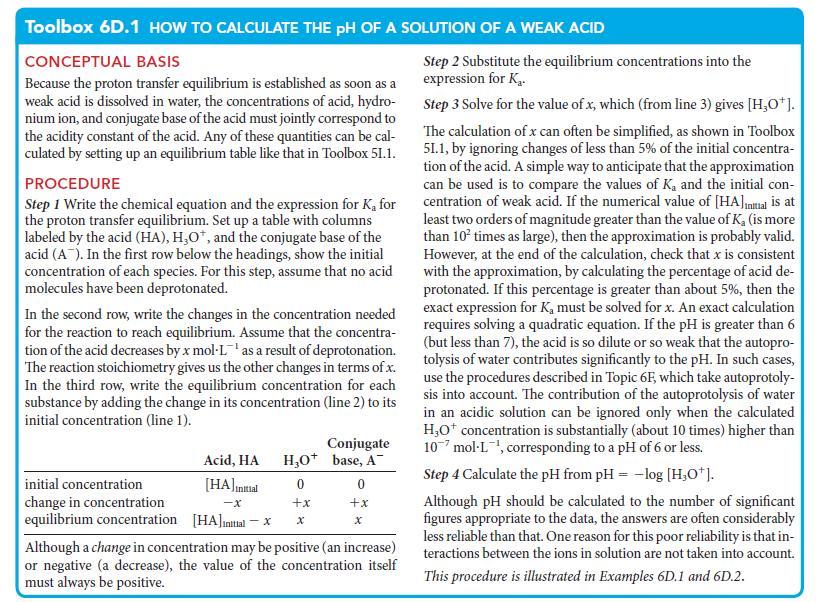Is the criterion 6 3CO 2 ) 2 (aq) is found to be 9.11. However, the contribution
Question:
Is the criterion 6 3CO2)2(aq) is found to be 9.11. However, the contribution to the pH from the autoprotolysis of water was ignored. Repeat the calculation of the pH of this solution, taking into account the autoprotolysis of water.
Example 6D.5
Calcium acetate, Ca(CH3CO2)2(aq), is used to treat patients with a kidney disease that results in high levels of phosphate ions in the blood. The calcium binds to the phosphates so that they can be excreted. If you are using calcium acetate for this purpose, it is important to know the pH of the solution to avoid complications in the treatment. Estimate the pH of 0.15 m Ca(CH3CO2)2(aq) at 25°C.
ANTICIPATE The CH3CO2– ion is the conjugate base of a weak acid; so the solution will be basic and you should expect pH > 7.
PLAN Use the procedure in Toolbox 6D.2, taking the initial concentration of base from the concentration of added salt. Calculate Kb for the basic anion from Ka for its conjugate acid. Convert pOH into pH by using Eq. 5b of Topic 6B (pH + pOH = 14.00).
What should you assume? As in Example 6D.2, you can make two assumptions initially: (1) because the protonation of the weak base is so small, the concentration of acetate ions retains its initial value; (2) the autoprotolysis of water does not affect the pH significantly. Be sure to verify these assumptions at the end of the calculation.
Example 6D.2
Although there are extensive tables available for the pKa of weak acids, you might be dealing with an unknown acid or a known acid at an unlisted temperature. You could then use a procedure like this to determine the Ka and pKa. The pH of a 0.010 m aqueous solution of a certain carboxylic acid is 2.95. What are its Ka and pKa?
ANTICIPATE All carboxylic acids are weak acids; therefore, expect Ka ≪ 1.
PLAN Calculate the hydronium ion concentration from the pH and then calculate the value of Ka from the equilibrium concentration of the acid and the hydronium ion concentration.
What should you assume? As in Example 6D.1, because pH
Example 6D.1
Acetic acid is a weak acid commonly found in both laboratory and household, but to what extent have its molecules actually been deprotonated? Calculate the pH and percentage deprotonation of CH3COOH molecules in 0.080 m CH3COOH(aq), given that Ka for acetic acid is 1.8 * 10–5.
ANTICIPATE Because the solution is that of an acid, expect pH
PLAN Following the procedure in Toolbox 6D.1, write the proton transfer equilibrium and construct the equilibrium table with concentrations in moles per liter.
What should you assume? You can make two assumptions, but they need to be verified at the end of the calculation.
(1) Deprotonation is so slight that the equilibrium concentration of the acid is approximately the same as its initial concentration.
(2) The autoprotolysis of water does not contribute significantly to the pH.
Step by Step Answer:

Chemical Principles The Quest For Insight
ISBN: 9781464183959
7th Edition
Authors: Peter Atkins, Loretta Jones, Leroy Laverman





